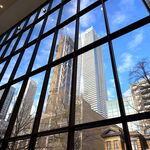There won't be much demand in HSR without the train culture first. For example, if we can build dedicated track for VIA, we could get the Toronto-Montreal trip down to 3.5 hrs without HSR. That would be a lot cheaper and allow us to serve a lot more people.
I think HSR will arrive in a phased manner within the lifetime of this generation growing up. Ten years is too optimistic, but I think we'll have a very profitable HSR business model for the London route by the 2030s (the early part the decade is only a single election cycle's of delay past 10 years). So I get the feeling that it will happen within a couple decades, possibly sooner, but two decades seem to be a good goal.
- GOTrain network becomes a true public transit supplement -- the GO RER initiative with frequent single decker electricified trains, planned extra infill stations, planned better integration with TTC, planned fare integration.
- SmartTrack is complete (Smarttrack is actually a GO RER in disguise), UP Express is complete
- Union station revitalization complete (3x GO concourse size)
- Electricification of lines through Union
- Interchange stations
By then, we have the train culture already necessary for enthusiasm about a high speed train. If dedicated high speed ROW is too pricy, we could at least go for a cheaper, simpler Acela Express style system which runs over existing electricified lines (already built for the rest of the GO network) and extend those to London, etc. This still gets London to Toronto quickly enough for tomorrow's daily commuters, fills the trains. I would prefer a dedicated ROW, they chose the London-to-Toronto route because it's a shorter route than Toronto-Ottawa (which I really want to see happen!). In one optimistic point of view, the expensive UP Express actually is a shrewd move to trojan-horse electricification (SmartTrack + UP Express + GO RER can use the same electrified ROW), as an initial phase of electrification on the Kitchener HSR route -- and tomorrow's 200-250kph HSR-lite "express train" to London could run over this existing electrified GO RER ROW all the way to Kitchener, and new ROWs can be gradually expropriated as a phased approach to a faster 350kph HSR. Kitchener commuters would catch the slow GO Trains, or pay more for a HSR train to commute to Toronto. The HSR is very complementary to GO RER, and electricification to Kitchener is part of GO RER, which conveniently electricifies half of the HSR route for a different reason! The money spent on HSR is actually not just HSR money but GO RER money so the same dollar can literally be spent on both for the gradual ROW improvements for faster GO RER and the HSR. I'd suspect that with 65 million people a year on GO Transit, and room in tomorrow's Union revitalization to increase that by 2-3x, there's enough population throughput to theoretically make a rare HSR profit (Metrolinx already being an agency with good farebox revenue coverage of operating costs (>80%) compared to lot of other transit agencies), or at least make it a viable business case that increases taxpayer return along the corridor that more than makes up for minor operating losses if it's not profitable.
That said, if all stars aligns (three levels of governments along the whole ROW) it could even happen in a ten year timeline. At least an Acela Express style 'speedup' before a dedicated ROW happens -- but I think a dedicated 350kph-capable ROW would be better (but that's the a luxury option). That said, we now have MANY reasons to begin electricifying now (SmartTrack, UP Express, GO RER, Union revitalization) and the same infrastructure can be adapted to support all those,
so the seeds of tomorrow's train culture is starting to be planted for a profitable 2030s HSR.




